Evaluation of Connected Vehicle Pavement Roughness Data for Statewide Needs Assessment
Abstract
1. Introduction
1.1. Paper Objective
1.2. Literature Review
2. Methods
2.1. Data Sources
2.1.1. Study Location
2.1.2. US Roads Dataset
2.1.3. IRICVe Data
2.1.4. Surface Type Data
2.2. Data Infrastructure
2.3. Route Network Preparation
2.3.1. Route Deduplication
2.3.2. Route Preprocessing
2.3.3. Data Mapping
3. Results
4. Discussion
5. Conclusions
- County-level roughness distributions were compared and provide a high-level overview of the distribution of road roughness across 92 counties and state-managed networks. In this figure, the interstate and state routes are the smoothest, while the county networks are clustered below them, indicating worse conditions.
- Spatiotemporal trends in data coverage were reviewed. Noteworthy observations include higher data coverage in urban counties and a statewide increase in paved local road coverage from 46.5% to 53.2% between 2023 and 2024, reflecting the growth in OEM CV deployments.
- County-level IRI category analysis showed variations in road conditions between counties with large and small road networks, seasonal increases in data coverage, and the impact of longer temporal aggregation on data coverage.
- Coverage increases by roughly 15% for yearly aggregation as opposed to monthly, highlighting the tradeoff between temporal granularity and data coverage when using IRICVe.
- A localized case study in Hamilton County illustrated the utility of the high spatial granularity of IRICVe. A route segment on E 221st Street showed an IRI improvement from 221 in/mi in 2023 to 94 in/mi in 2024, and maintenance work was confirmed with independent Google Street View imagery. The case study validates the potential of using IRICVe for automated roughness change detection for proactive network screening.
Author Contributions
Funding
Data Availability Statement
Acknowledgments
Conflicts of Interest
Abbreviations
| PCI | Pavement Condition Index |
| PASER | Pavement Surface Evaluation and Rating |
| IRI | International Roughness Index |
| CV | Connected Vehicle |
| IRICVe | CV-estimated IRI |
| IMU | Inertial Measurement Unit |
| LiDAR | Light Detection and Ranging |
| OEM | Original Equipment Manufacturer |
| API | Application Programming Interface |
| FHWA | Federal Highway Administration |
| TRB | Transportation Research Board |
| INDOT | Indiana Department of Transportation |
| STGNN | Spatiotemporal Graph Neural Network |
References
- Indiana Local Technical Assistance Program. Local Road & Bridge Condition Report: County/City/Town; Indiana Local Technical Assistance Program: West Lafayette, IN, USA, 2019; Available online: https://www.buildindianacouncil.org/wp-content/uploads/2019/10/LTAP_2019-Local-Road-and-Bridge-Condition-Report-1.pdf (accessed on 23 July 2025).
- Applied Pavement Technology, Inc. Indiana Local Roads: An Asset Management Guide for Cities, Towns and Counties; Indiana Local Technical Assistance Program: West Lafayette, IN, USA, 2017; Available online: https://www.asphaltindiana.org/docs/2-LTAP_Asset_Management_Guide.pdf (accessed on 23 July 2025).
- Indiana Department of Transportation. Transportation Asset Management Plan (TAMP); Indiana Department of Transportation: Indianapolis, IN, USA, 2022. Available online: https://www.in.gov/indot/files/2022-TAMP.pdf (accessed on 23 July 2025).
- National Operations Center of Excellence. Connected Vehicle Data. Available online: https://data.transportationops.org/connected-vehicle-data (accessed on 25 July 2025).
- Gopalakrishnan, K. Deep Learning in Data-Driven Pavement Image Analysis and Automated Distress Detection: A Review. Data 2018, 3, 28. [Google Scholar] [CrossRef]
- Owor, N.J.; Du, H.; Daud, A.; Aboah, A.; Adu-Gyamfi, Y. Image2PCI—A Multitask learning framework for estimating pavement condition indices directly from images. arXiv 2023, arXiv:2310.08538. [Google Scholar]
- ASTM International. Standard Practice for Roads and Parking Lots Pavement Condition Index Surveys (ASTM D6433 20); ASTM International: West Conshohocken, PA, USA, 2020. [Google Scholar] [CrossRef]
- Wisconsin Transportation Information Center. PASER Manual: Asphalt Pavement Surface Evaluation and Rating, 2nd ed.; University of Wisconsin–Madison: Madison, WI, USA, 2013; Available online: https://ltap.engr.wisc.edu/wp-content/uploads/2019/12/Asphalt-PASER_02_rev13.pdf (accessed on 23 July 2025).
- Federal Highway Administration 2024 Pavements—Inertial Profiler—Pavement (IP). Available online: https://infotechnology.fhwa.dot.gov/inertial-profiler-road-pavement/ (accessed on 23 July 2025).
- Abohamer, H.; Elseifi, M.; Dhakal, N.; Zhang, Z.; Fillastre, C.N. Development of a Deep Convolutional Neural Network for the Prediction of Pavement Roughness from 3D Images. J. Transp. Eng. Part B Pavements 2021, 147, 04021048. [Google Scholar] [CrossRef]
- De Blasiis, M.R.; Di Benedetto, A.; Fiani, M.; Garozzo, M. Assessing of the Road Pavement Roughness by Means of LiDAR Technology. Coatings 2021, 11, 17. [Google Scholar] [CrossRef]
- Justin, M.; Howell, L.; Björn, Z.; Dustin, L.; Darcy, B. Pavement Quality Evaluation Using Connected Vehicle Data. Sensors 2022, 22, 9109. [Google Scholar] [CrossRef] [PubMed]
- Mahlberg, J.A.; Li, H.; Zachrisson, B.; Mathew, J.K.; Bullock, D.M. Applications of using connected vehicle data for pavement quality analysis. Front. Future Transp. 2024, 4, 1239744. [Google Scholar] [CrossRef]
- Zachrisson, B.; Hägg, J.; Frank, H.; Petersson, J.; Noren, O. Probe vehicle data as input source for road maintenance. In Roads and Airports Pavement Surface Characteristics: Proceedings of the 9th Symposium on Pavement Surface Characteristics (SURF 2022, 12–14 September 2022, Milan, Italy); Crispino, M., Toraldo, E., Eds.; CRC Press: Boca Raton, FL, USA, 2023; pp. 159–167. [Google Scholar] [CrossRef]
- Llopis-Castelló, D.; Camacho-Torregrosa, F.J.; Romeral-Pérez, F.; Tomás-Martínez, P. Estimation of Pavement Condition Based on Data from Connected and Autonomous Vehicles. Infrastructures 2024, 9, 188. [Google Scholar] [CrossRef]
- Agebjär, M.; Zetterqvist, G.; Gustafsson, F.; Wahlström, J.; Hendeby, G. Road Roughness Estimation via Fusion of Standard Onboard Automotive Sensors. In Proceedings of the 2025 28th International Conference on Information Fusion (FUSION), Rio de Janeiro, Brazil, 7–11 July 2025; Available online: https://www.niradynamics.com/hubfs/FUSION_2025___Nira%205.pdf (accessed on 25 July 2025).
- Mathew, J.; Desai, J.; Sakhare, R.; Hunter, J.; Bullock, D. Spatiotemporal Analysis of Pavement Roughness Using Connected Vehicle Data for Asset Management. J. Transp. Technol. 2025, 15, 188. [Google Scholar] [CrossRef]
- Mussah, A.R.; Shoman, M.; Amo-Boateng, M.; Adu-Gyamfi, Y. Accelerating statewide connected vehicles big (sensor fusion) data ETL pipelines on GPUs. arXiv 2023, arXiv:2305.07454. [Google Scholar] [CrossRef]
- Li, S.; Dragicevic, S.; Castro, F.A.; Sester, M.; Winter, S.; Coltekin, A.; Pettit, C.; Jiang, B.; Haworth, J.; Stein, A.; et al. Geospatial big data handling theory and methods: A review and research challenges. ISPRS J. Photogramm. Remote Sens. 2016, 115, 119–133. [Google Scholar]
- National Cooperative Highway Research Program. Guidebook for Data and Information Systems for Transportation Asset Management; The National Academies Press: Washington, DC, USA, 2022; Available online: https://onlinepubs.trb.org/onlinepubs/nchrp/docs/NCHRP08-115FinalReport.pdf (accessed on 25 July 2025).
- Purdue University Local Technical Assistance Program. Indiana Local Road and Bridge Report; Purdue University: West Lafayette, IN, USA, 2024; Available online: https://www.purdue.edu/inltap/resources/2024-08-20-Indiana-Local-Road-and-Bridge-Report---FINAL.pdf (accessed on 23 July 2025).
- US Roads Dataset. Google Cloud Console. Available online: https://console.cloud.google.com/marketplace/product/united-states-census-bureau/all-roads?hl=en&inv=1&invt=Ab27_Q&project=yt-dl-443015 (accessed on 23 July 2025).
- Federal Highway Administration 2024 Office of Highway Policy Information. Available online: https://www.fhwa.dot.gov/policyinformation/pubs/hf/pl11028/chapter7.cfm (accessed on 23 July 2025).
- Indiana Geographic Information Office. LRSE Surface Type [Feature Layer]. IndianaMap. Available online: https://gisdata.in.gov/server/rest/services/Hosted/LRSE_Surface_Type/FeatureServer/10 (accessed on 23 July 2025).
- Google Cloud. BigQuery Pricing. Google Cloud. Available online: https://cloud.google.com/bigquery/pricing (accessed on 23 July 2025).
- Google. BigQuery GeoViz. Google Cloud. Available online: https://bigquerygeoviz.appspot.com/ (accessed on 23 July 2025).
- Indiana Geographic Information Office. County Boundaries of Indiana (Current). IndianaMap. Available online: https://www.indianamap.org/datasets/INMap::county-boundaries-of-indiana-current/explore (accessed on 23 July 2025).
- Indiana Geographic Information Office. INDOT Districts. IndianaMap. Available online: https://www.indianamap.org/datasets/INMap::indot-districts/explore?location=39.697884%2C-86.424450%2C6.74 (accessed on 23 July 2025).
- Gao, Y.; Yang, K.; Yue, Y.; Wu, Y. A vehicle trajectory prediction model that integrates spatial interaction and multiscale temporal features. Sci. Rep. 2025, 15, 8217. [Google Scholar] [CrossRef] [PubMed]
- Chen, Y.T.; Liu, A.; Li, C.; Li, S.; Yang, X. Traffic flow prediction based on spatial-temporal multi factor fusion graph convolutional networks. Sci. Rep. 2025, 15, 12612. [Google Scholar] [CrossRef] [PubMed]
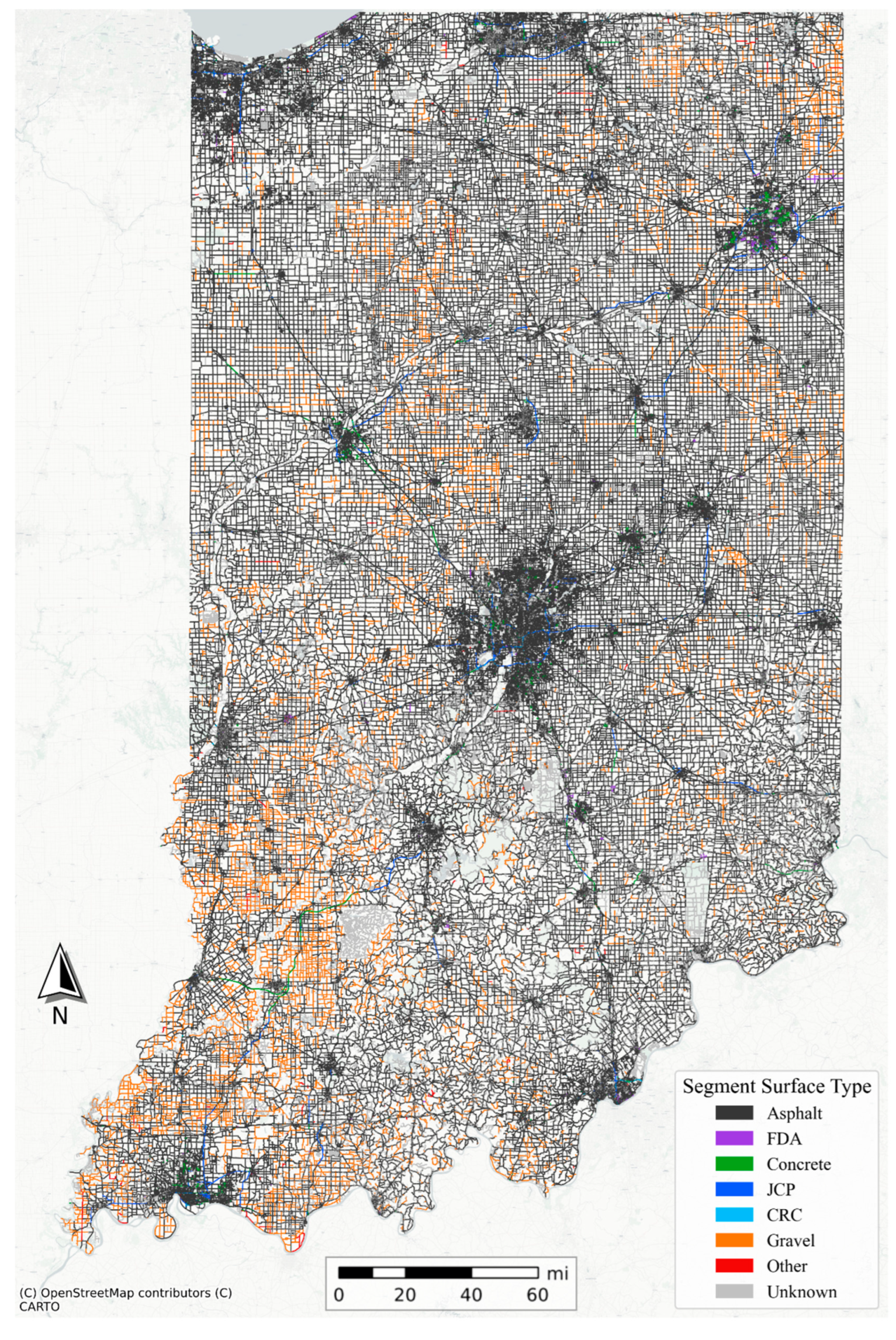
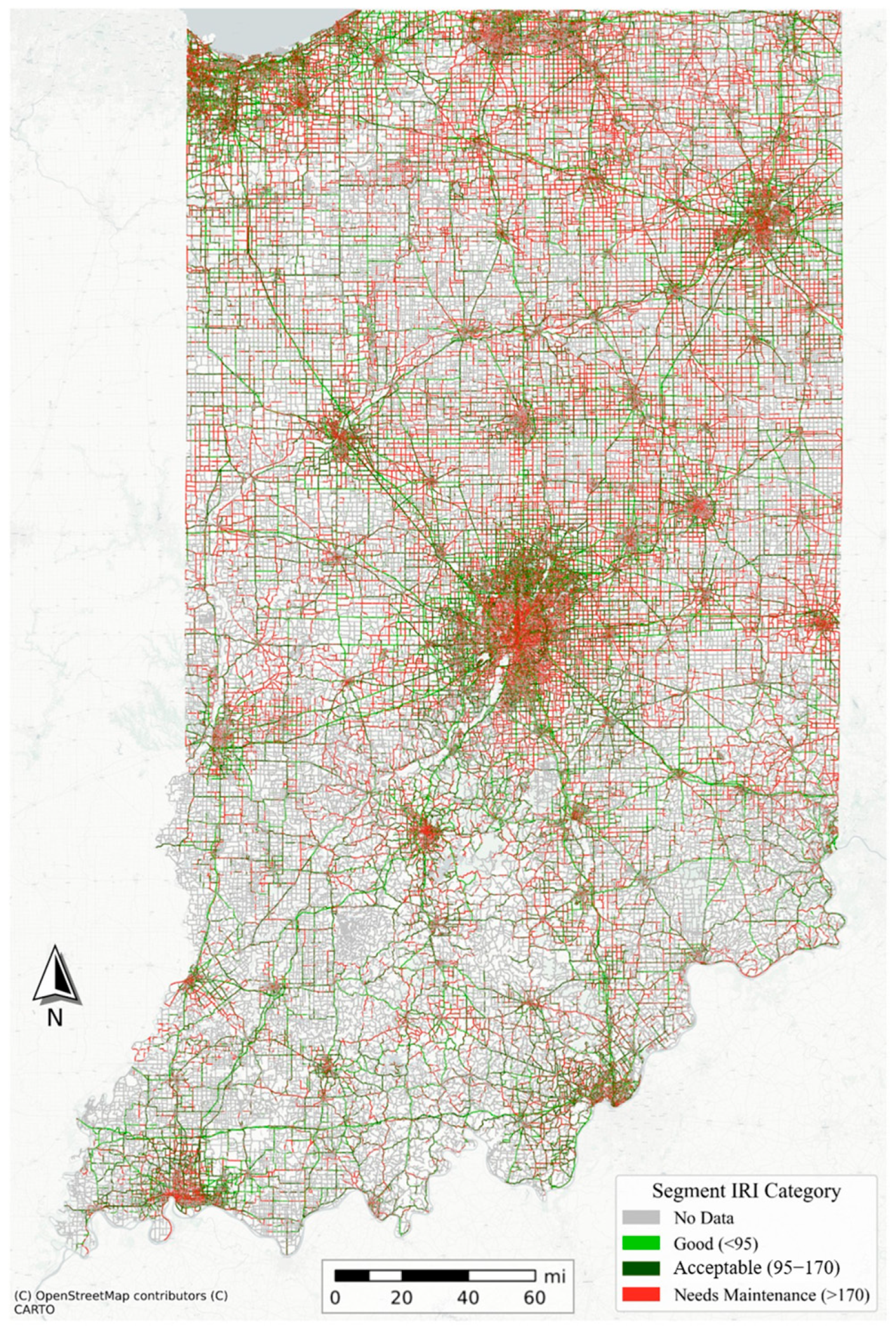
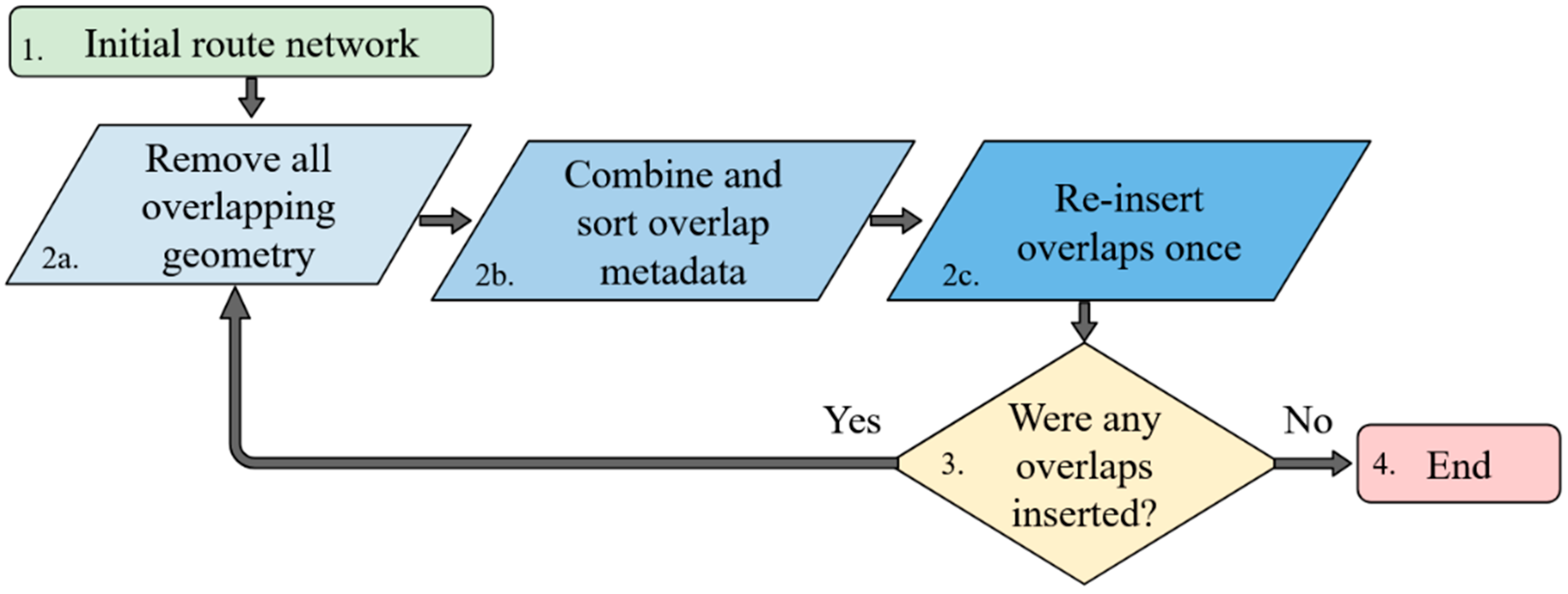
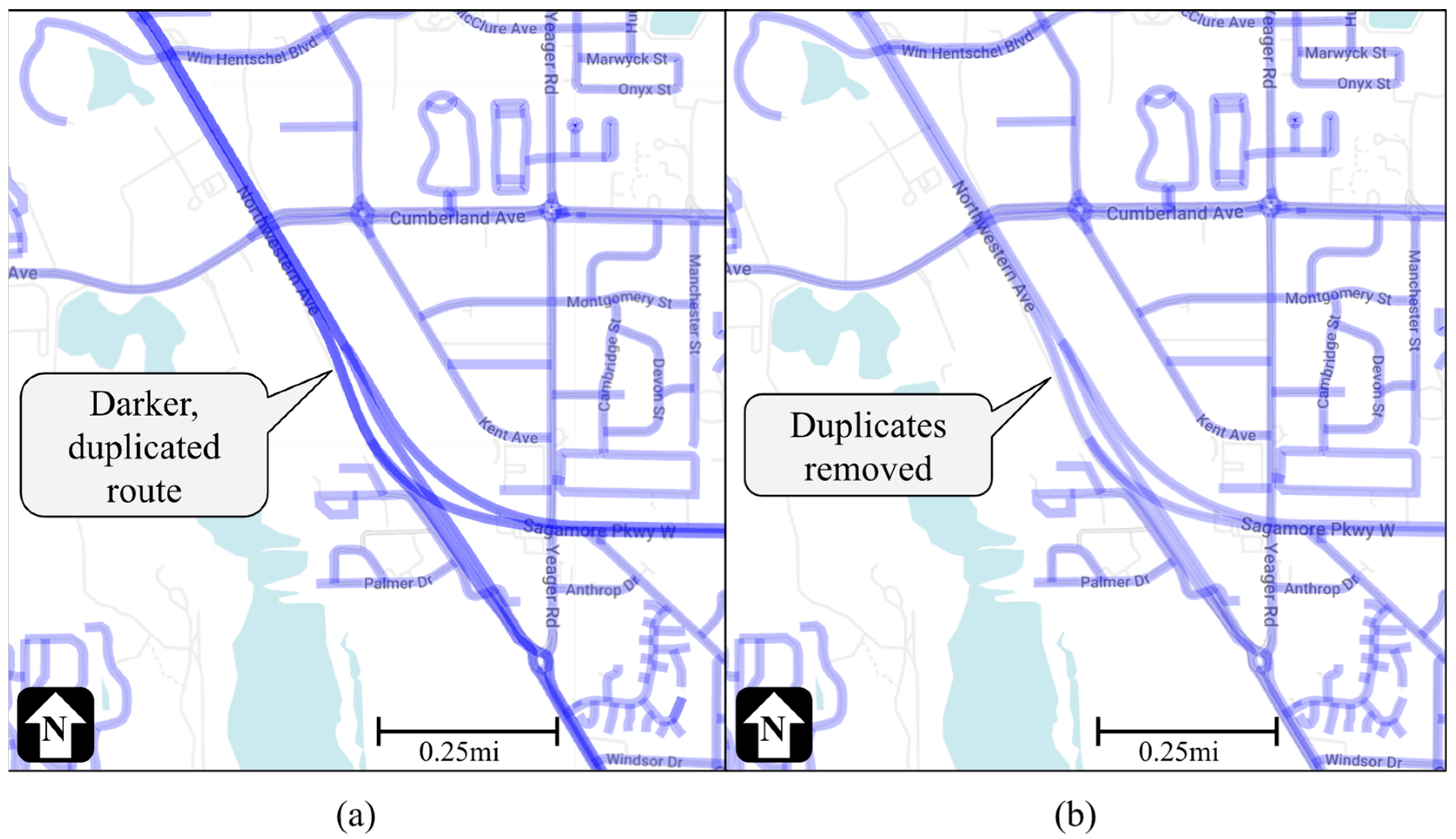
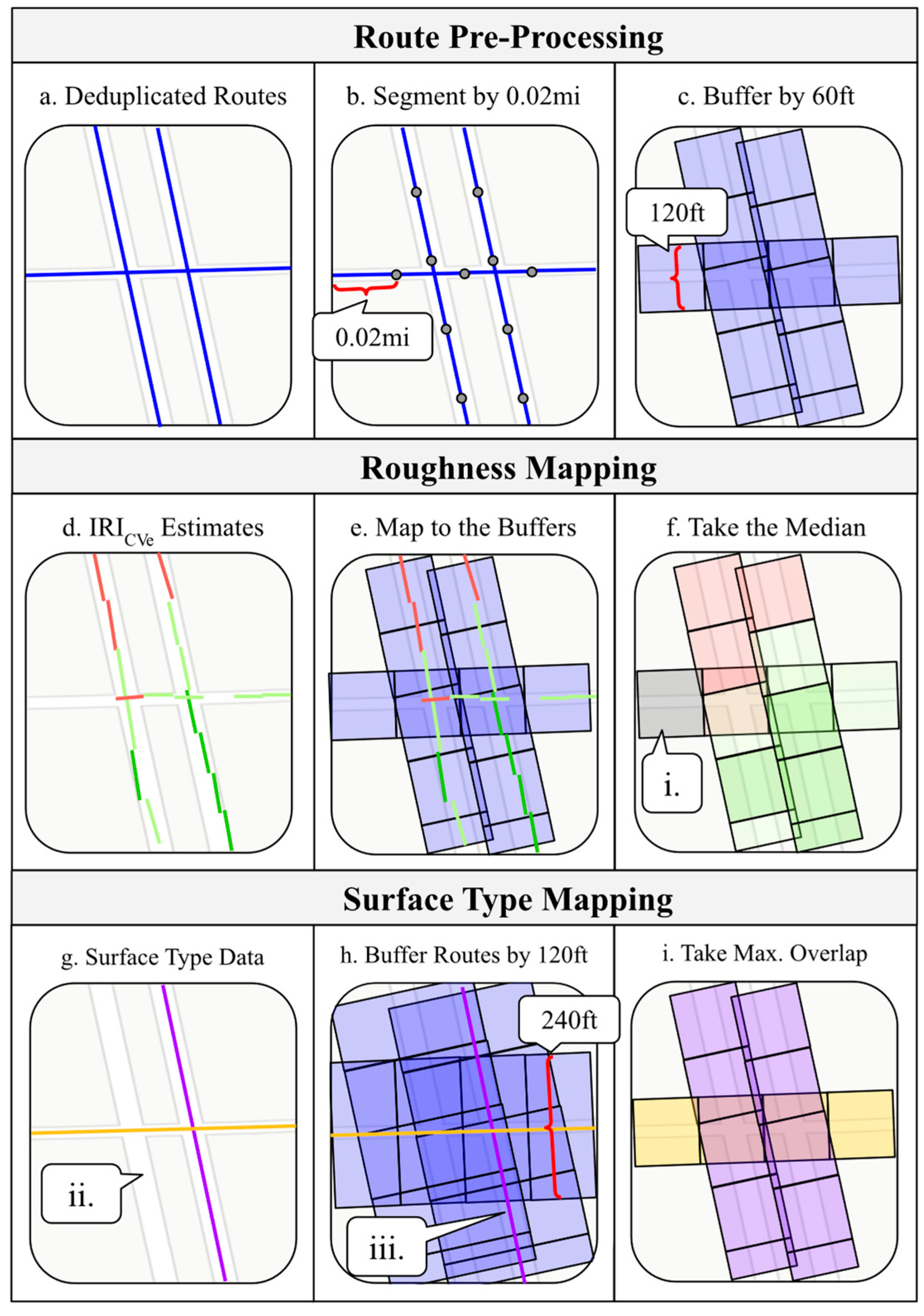
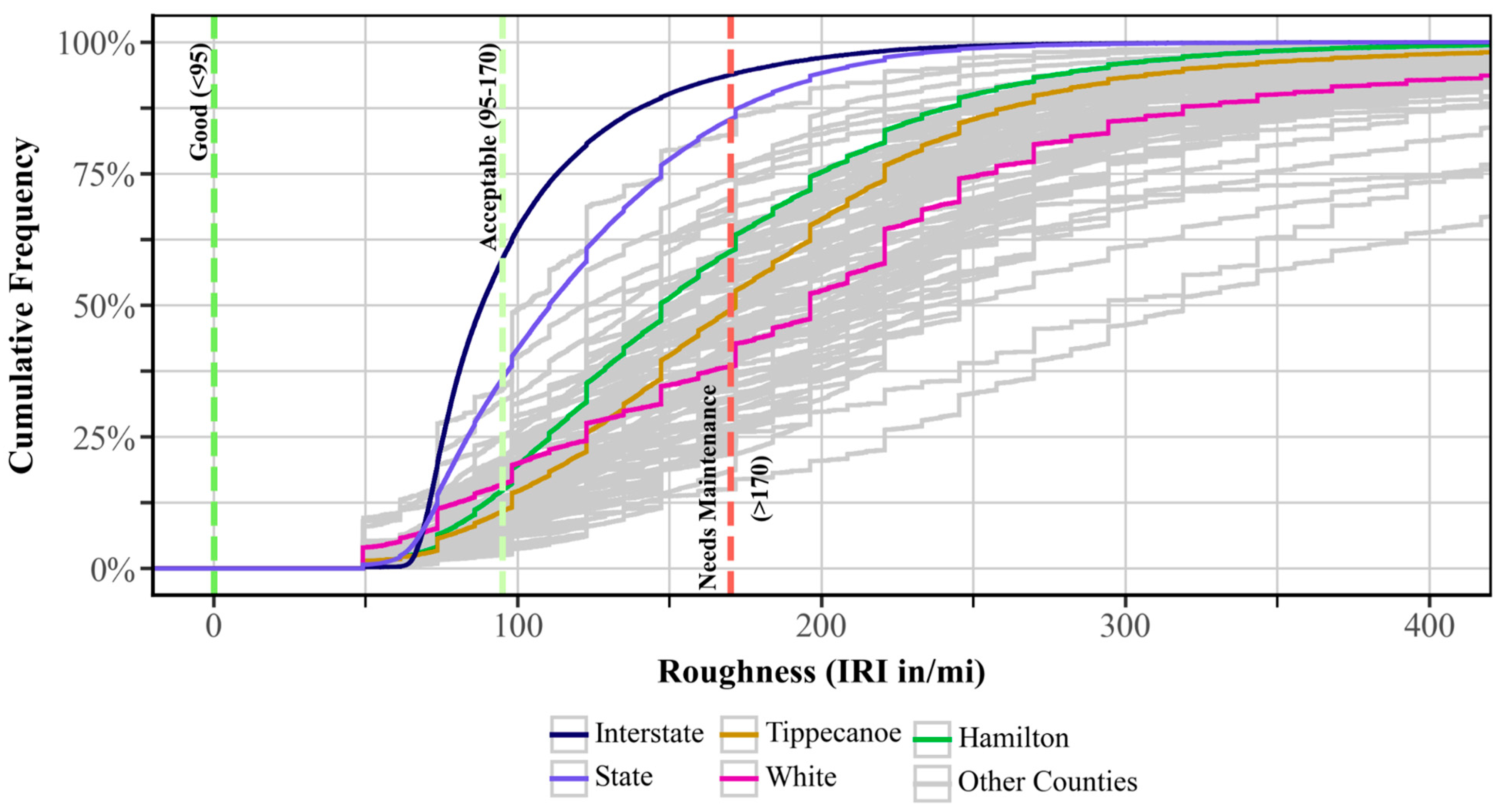
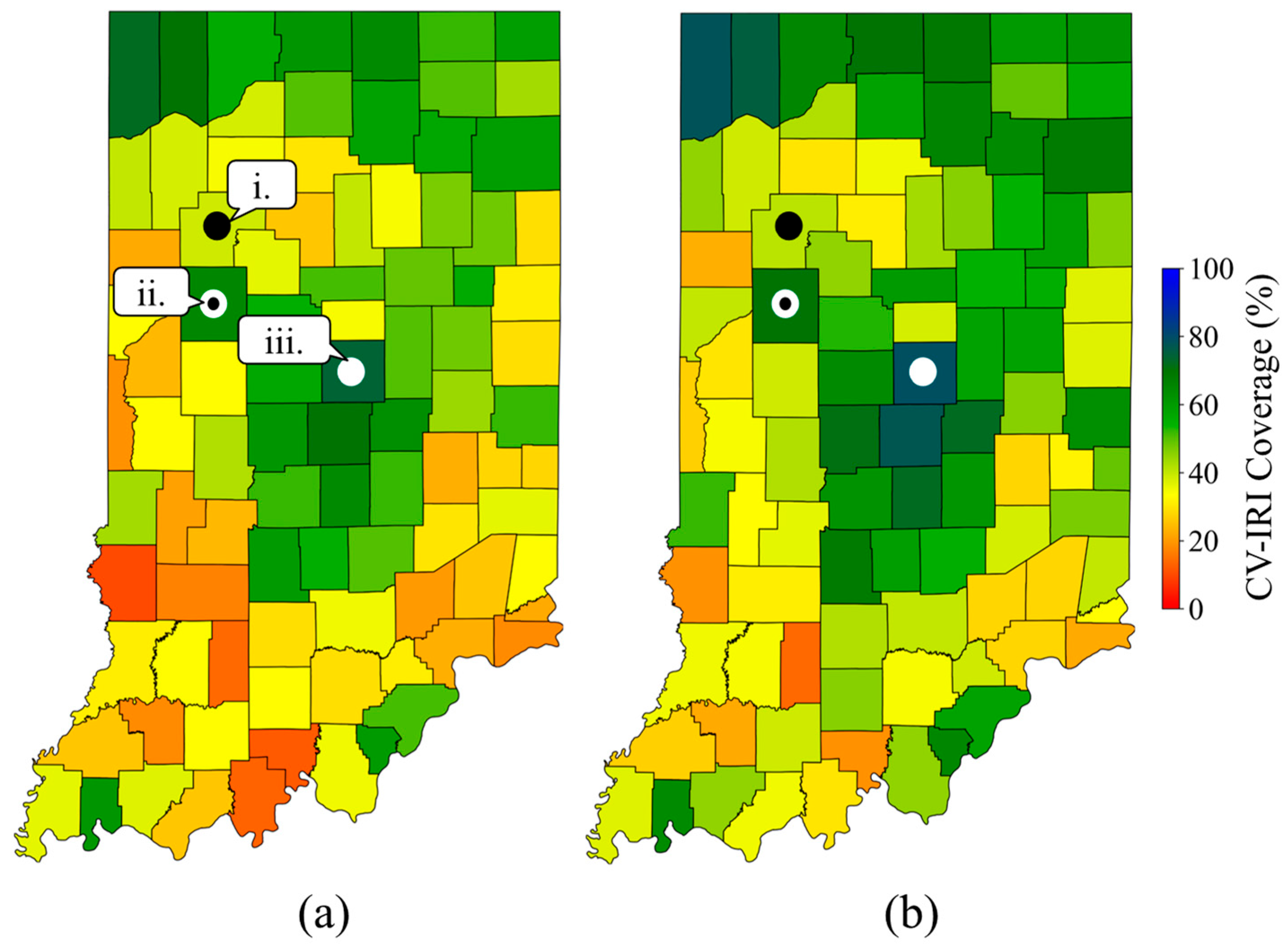
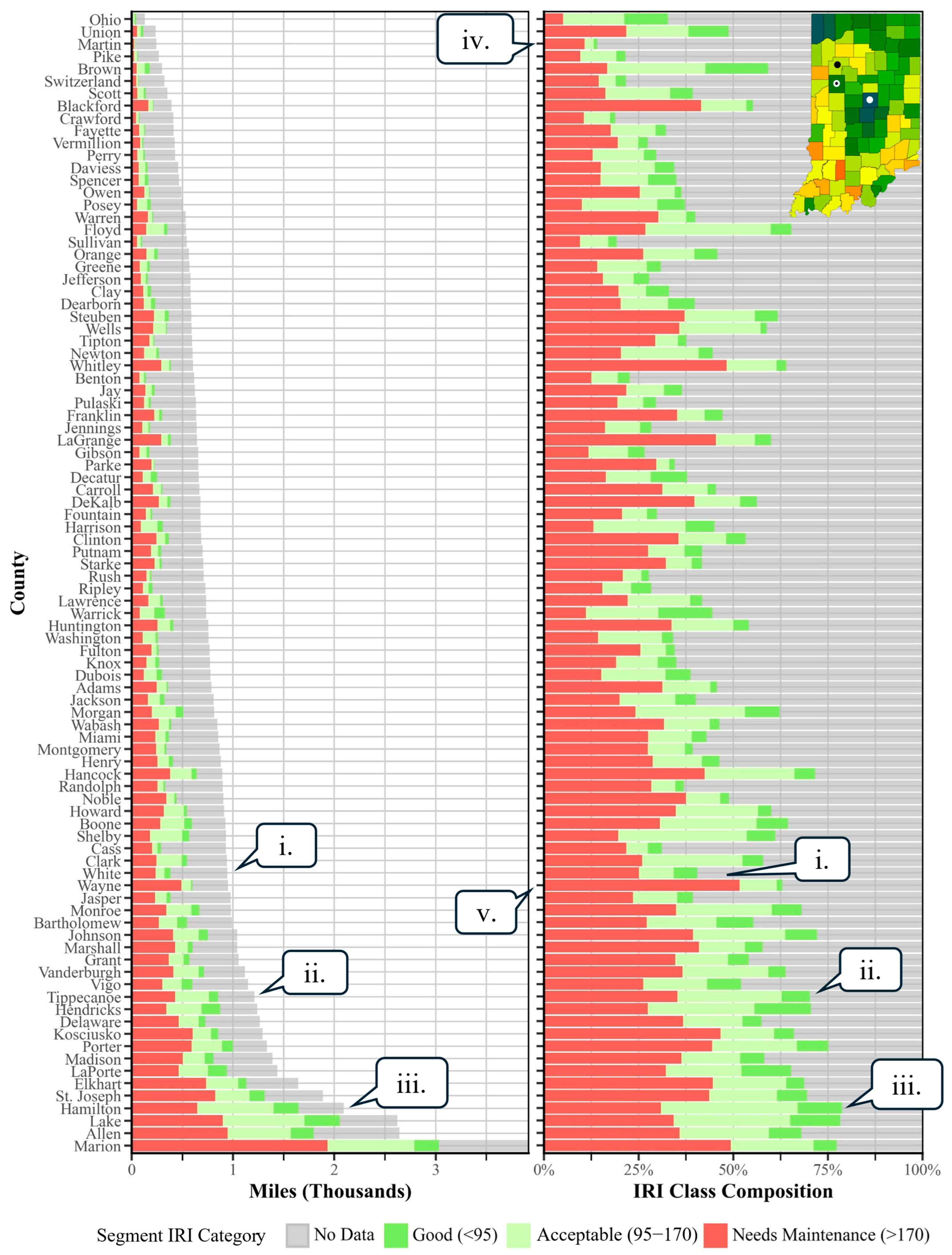
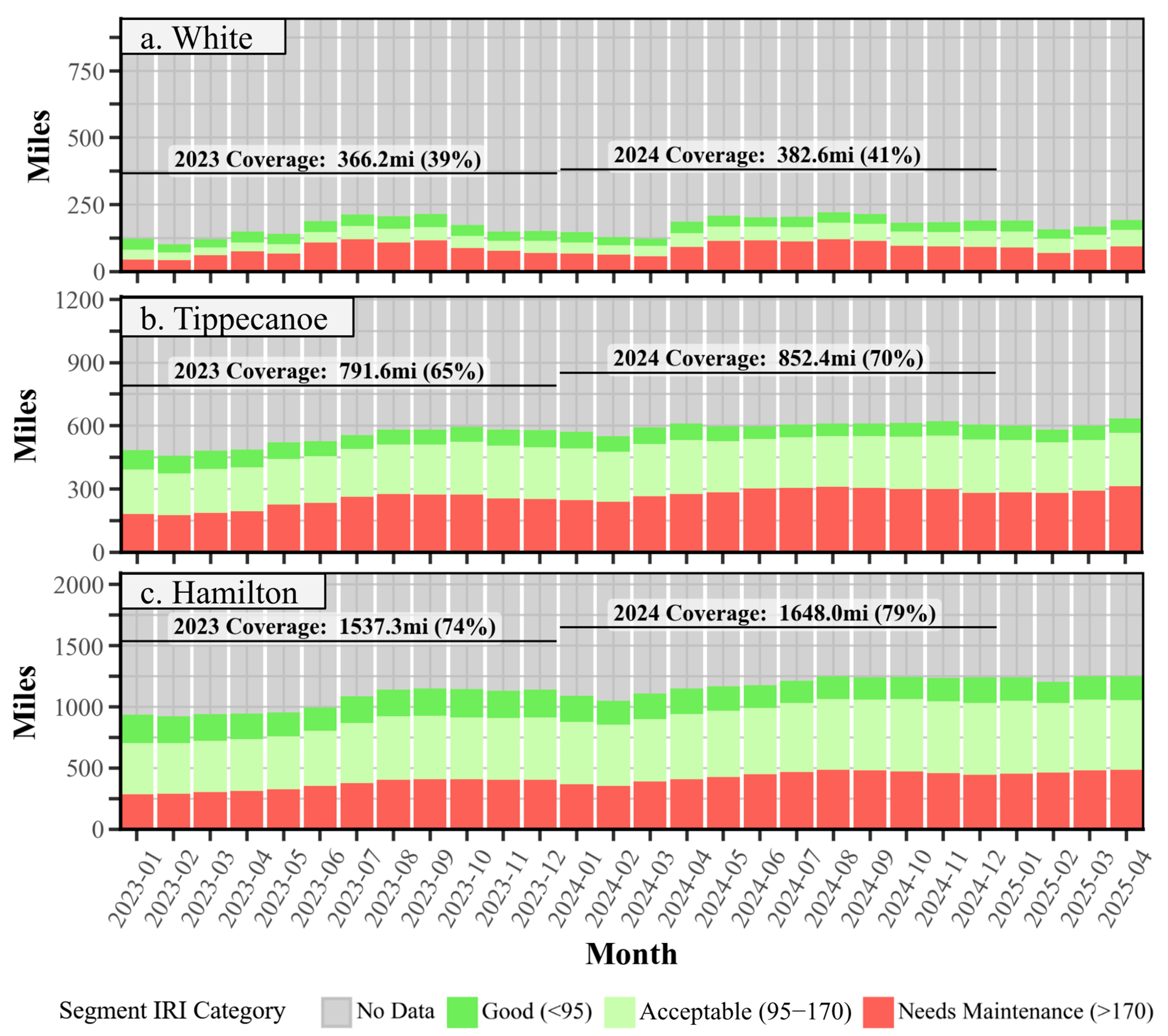
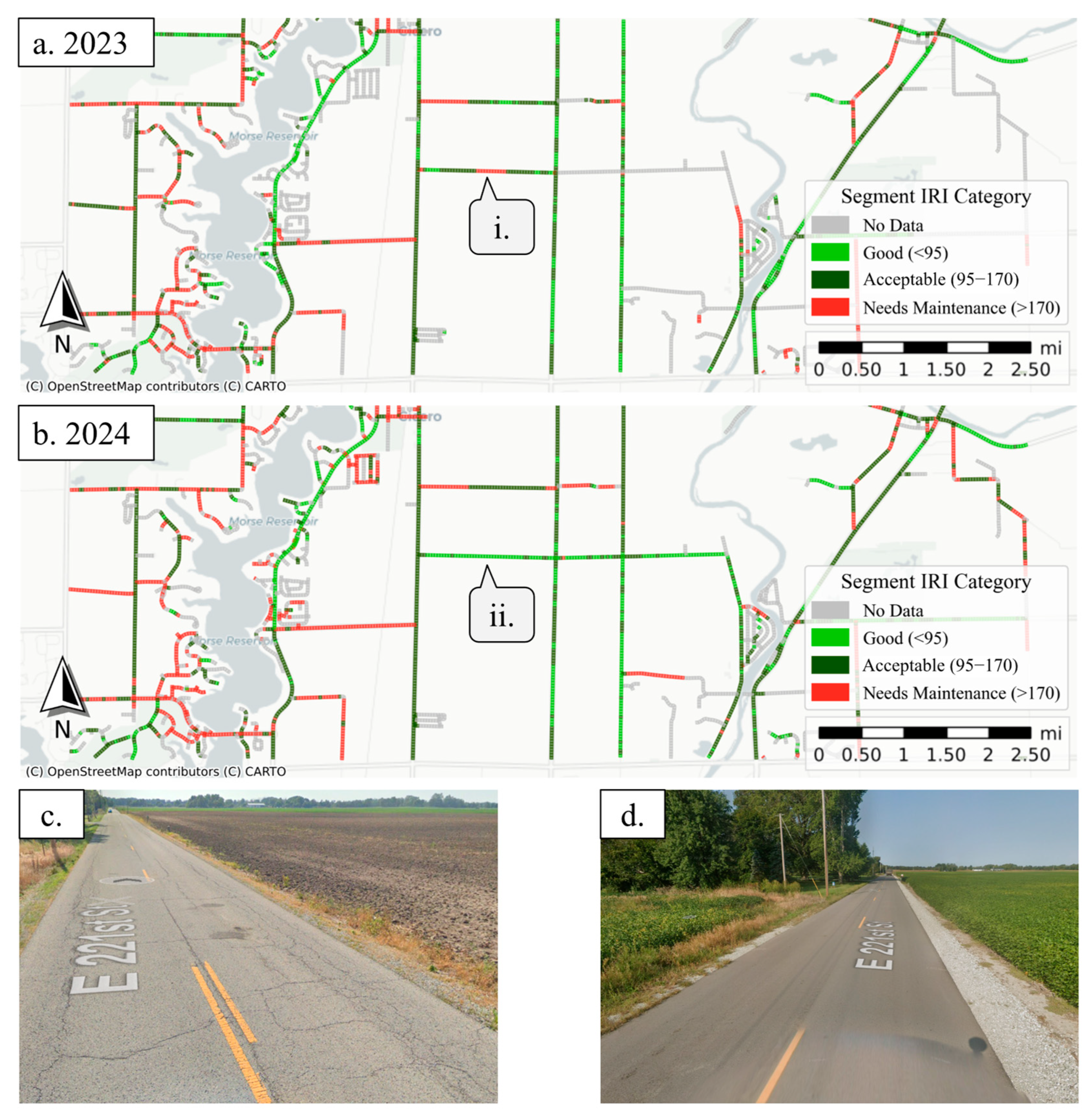
Disclaimer/Publisher’s Note: The statements, opinions and data contained in all publications are solely those of the individual author(s) and contributor(s) and not of MDPI and/or the editor(s). MDPI and/or the editor(s) disclaim responsibility for any injury to people or property resulting from any ideas, methods, instructions or products referred to in the content. |
© 2025 by the authors. Licensee MDPI, Basel, Switzerland. This article is an open access article distributed under the terms and conditions of the Creative Commons Attribution (CC BY) license (https://creativecommons.org/licenses/by/4.0/).
Share and Cite
Thompson, A.; Desai, J.; Bullock, D.M. Evaluation of Connected Vehicle Pavement Roughness Data for Statewide Needs Assessment. Infrastructures 2025, 10, 248. https://doi.org/10.3390/infrastructures10090248
Thompson A, Desai J, Bullock DM. Evaluation of Connected Vehicle Pavement Roughness Data for Statewide Needs Assessment. Infrastructures. 2025; 10(9):248. https://doi.org/10.3390/infrastructures10090248
Chicago/Turabian StyleThompson, Andrew, Jairaj Desai, and Darcy M. Bullock. 2025. "Evaluation of Connected Vehicle Pavement Roughness Data for Statewide Needs Assessment" Infrastructures 10, no. 9: 248. https://doi.org/10.3390/infrastructures10090248
APA StyleThompson, A., Desai, J., & Bullock, D. M. (2025). Evaluation of Connected Vehicle Pavement Roughness Data for Statewide Needs Assessment. Infrastructures, 10(9), 248. https://doi.org/10.3390/infrastructures10090248





